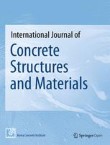International Journal of Concrete Structures and Materials is affiliated with Korea Concrete Institute.
Characterizations and Quantitative Estimation of Alkali-Activated Binder Paste from Microstructures
Alkali-activated binder (AAB) is recently being considered as a sustainable alternative to portland cement (PC) due to its low carbon dioxide emission and diversion of industrial wastes and by-products such as...
